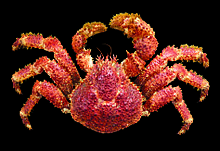Paralomis
| Paralomis | |
|---|---|

| |
| Paralomis granulosa | |
| Scientific classification | |
| Domain: | Eukaryota |
| Kingdom: | Animalia |
| Phylum: | Arthropoda |
| Class: | Malacostraca |
| Order: | Decapoda |
| Suborder: | Pleocyemata |
| Infraorder: | Anomura |
| Family: | Lithodidae |
| Subfamily: | Lithodinae |
| Genus: | Paralomis White, 1856[1] |
| Type species | |
| Paralomis granulosa (Hombron & Jacquinot, 1846)
| |
| Synonyms[2] | |
| |
Paralomis is a widely distributed, highly speciose, and morphologically diverse genus of king crabs in the subfamily Lithodinae.[2][3]
Description
[edit]Like all king crabs, Paralomis has evolved a crab-like appearance through a process called carcinisation.[3] Paralomis has either a pentagonal or pyriform carapace.[3] At the very front, its rostrum consists of one short, conical spine projecting forward in the middle and one or more pairs of spines angled upward around the base.[3][4] Like all king crabs, the gastric region, directly behind the rostrum, is elevated above the others.[3] Like Lithodes and Neolithodes, the cardiac region – directly behind the gastric region, separated by a deep groove – is triangular.[3] Its three pairs of walking legs – morphologically similar, with the middle pair typically being the longest – are not covered at their bases by the carapace.[3] In adults, the undersides of the dactyli feature horn-like spines.[3] The abdomen is more calcified than in other king crab genera: the second segment is undivided, the third segment has fused submedian and marginal (outer) plates, and segments three, four, and five are all entirely calcified.[3]
Distribution
[edit]Paralomis is present in four of Earth's five oceans – namely the Atlantic, Pacific, Indian, and Southern – as well as all seven continents.[3] They are found from the very shallow intertidal zone to the deep, perpetually dark abyssal zone.[4] The deepest known species of Paralomis is P. bouvieri, which has been discovered living at 4,152 m (13,622 ft).[3]
Taxonomy
[edit]Paralomis was described in 1856 by zoologist Adam White and named for its similarity to the genus Lomis.[1] In 1895, marine biologist James Everard Benedict incorrectly placed Paralomis granulosa, the genus' type species, under the genus Lithodes.[5][3] Benedict therefore dissolved the genus and created two now-defunct ones – Leptolithodes and Pristopus – for other members of Paralomis.[5][3] Paralomis is closely related to Echidnocerus, and the monospecific genus Glyptolithodes – nested cladistically inside Paralomis – may simply be a species of Paralomis.[6][7][8]
Paralomis contains over 70 species – more than any other king crab genus – and is the most morphologically diverse genus in the subfamily Lithodinae.[3][4] It contains one fossil species, Paralomis debodeorum, which lived in New Zealand in the Middle–Late Miocene.[3] Paralomis is distinguished from other king crabs by its abdominal segments: the second is undivided, and the third, fourth, and fifth are entirely calcified.[3] Current scientific consensus is that Paralomis is monophyletic, although within this group, carcinologist Shane T. Ahyong in 2010 identified several informal subgroups of Paralomis.[3] Paralomis' relationship to other king crabs can be seen in the following cladogram:[6]
Lithodidae cladogram
|
|---|
Species
[edit]Paralomis contains the following species:[2]
References
[edit]- ^ a b White, Adam (1856). "Some remarks on Crustacea of the genus Lithodes, with a brief description of a species apparently hitherto unrecorded". Proceedings of the Zoological Society of London: 132–135. Retrieved 29 November 2024.
- ^ a b c Ahyong, Shane T. (12 December 2023). "Paralomis White, 1856". WoRMS. World Register of Marine Species. Retrieved 21 October 2024.
- ^ a b c d e f g h i j k l m n o p q Ahyong, Shane T. (2010). The Marine Fauna of New Zealand: King Crabs of New Zealand, Australia, and the Ross Sea (Crustacea: Decapoda: Lithodidae) (PDF). NIWA Biodiversity Memoirs. Vol. 123. National Institute of Water and Atmospheric Research. pp. 108–110. ISBN 978-0478232851. LCCN 2010497356. Archived (PDF) from the original on 15 February 2020.
- ^ a b c Poore, Gary C. B.; Ahyong, Shane T. (2023). "Anomura". Marine Decapod Crustacea: A Guide to Families and Genera of the World. CRC Press. pp. 311–317. ISBN 978-1-4863-1178-1.
- ^ a b Benedict, James Everard (1895). "Descriptions of new genera and species of crabs of the family LIthodidæ, with notes on the young of Lithodes camtschaticus and Lithodes brevipes". Proceedings of the United States National Museum. 17: 479–488. Retrieved 30 November 2024 – via the Internet Archive.
- ^ a b Noever, Christoph; Glenner, Henrik (2017-07-05). "The origin of king crabs: hermit crab ancestry under the magnifying glass" (PDF). Zoological Journal of the Linnean Society. 182 (2): 300–318. doi:10.1093/zoolinnean/zlx033. Archived (PDF) from the original on 2019-07-16 – via the University of Copenhagen.
- ^ Hall, Sally; Thatje, Sven. "Evolution through cold and deep waters: the molecular phylogeny of the Lithodidae (Crustacea: Decapoda)". The Science of Nature. 105. article 19. Bibcode:2018SciNa.105...19H. doi:10.1007/s00114-018-1544-2. PMC 5829116. PMID 29488024.
- ^ Macpherson, Enrique (May 1988). "Revision of the family Lithodidae Samouelle, 1819 (Crustacea: Decapoda: Anomura) in the Atlantic Ocean" (PDF). Monografías de Zoología Marina. II: 23. ISSN 0213-4020. Archived (PDF) from the original on May 14, 2020 – via the Natural History Museum of Los Angeles County.

















